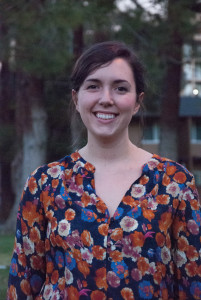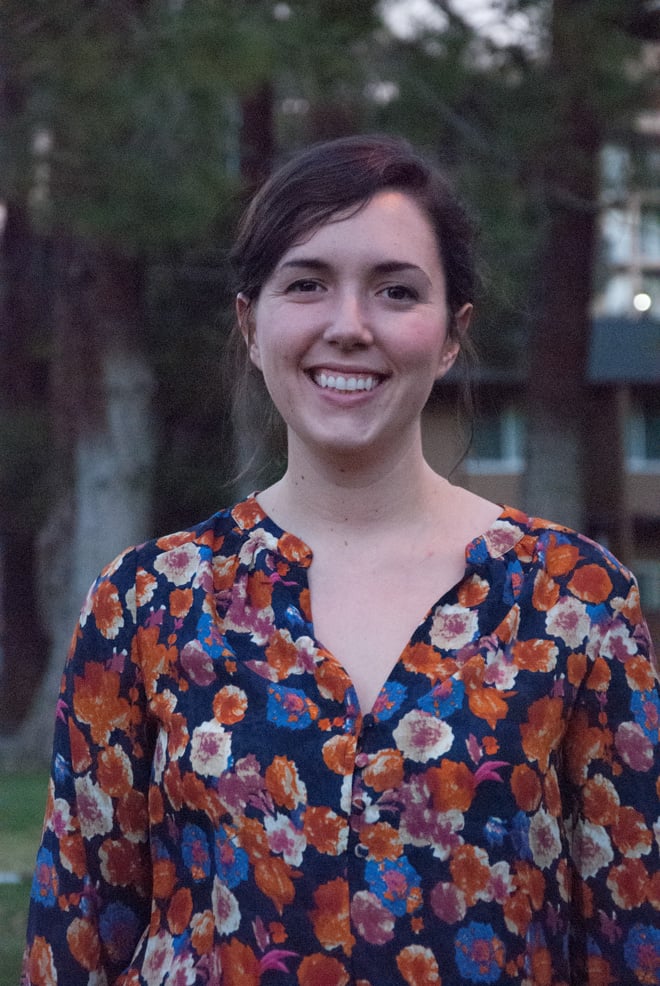
Quick-witted and exceedingly personable, MFA student Kristine Stolakis ‘15 is the kind of woman that you could wind up talking to for hours. Fortunately for Stolakis, this attribute has been utterly critical in her chosen line of work: documentary filmmaking.
After receiving an undergraduate degree in cultural anthropology from New York University, Stolakis elected to pack up her bags and head west, with the intention of receiving an MFA from Stanford University’s prestigious documentary film program. Now in her second year of the two-year course of study, Stolakis is just months — and a finished thesis — away from graduating.
To date, Stolakis has produced three films while at Stanford. The first, “Funny People,” deals with the difficulty of making a career out of stand-up comedy; the second, “Balancing Act,” paints a portrait of a performer, DeMarcello, and the circus-oriented after school program with which he is involved; and the third, “The Typist,” features a detailed re-enactment of an interview with a gay Korean war veteran.
Although Stolakis is hard at work checking off requirements and shaping her final project (an exploration of Mormon feminism), Stolakis kindly agreed to sit down with The Daily’s Will Ferrer to converse about everything from her recent work to the absence of female directors in today’s industry.
The Stanford Daily (TSD): Since you didn’t study film at NYU, when is it that you got into filmmaking?
Kristine Stolakis (KS): The million-dollar question. I feel like every time I answer this question I give a different answer, and I think it’s because, in retrospect, it’s the most obvious thing. I didn’t grow up in an arts family at all, and I didn’t really even watch documentaries until college. They weren’t in my worldview. So I think that it just hit me super late that it was even an option. I would say the real answer is, I was doing community arts work, and I loved it. But I was starting to feel like theater was not as accessible of a medium as I wanted the work that I was a part of to be. I was getting more excited about film. More people can see film. It’s cheaper to see film. All the kids I was working with were into film. Film felt more relevant.
TSD: To get into your work, could you describe the most recent project that you worked on?
KS: Yes. So the most recent project I did was in the spring. I did a film that is called “The Typist.” It is a film about a Korean war veteran who is gay, and during the war, he was in charge of writing the dishonorable discharges of people who were found out to be gay. At that time, and until quite recently, in the military and the U.S., it was against the law of the land to be gay and serve, so you were discharged if you were found out.
TSD: I know most of our readers haven’t had the chance to view “The Typist,” but something I found really interesting about that film was your employment of B-roll — including some of the archival images of weddings, threshold-crossing, etc. — as metaphorical representation of the concepts discussed in the audio track. Is this something that you see as indicative of your style?
KS: I really am seeing film school as a process of learning about myself and my voice. I feel like a very young filmmaker, and I’m still really finding that voice. And that’s something I really love about “The Typist”: I discovered a lot about myself in that process. For instance, I discovered that I’m really language-driven. To answer your question of how I arrived at the use of [archival footage], I started by creating what’s called the radio edit. I was working with this archival audio, and I made a cut of just the sound, just the story. Then, from there, I used the simple process of word association where I thought to myself, “What are the images that evoke this time period?” I wanted it to feel not like a scene but like memory, or a dream, that kind of comes back to you in glimpses.
TSD: Do you ever drop a film? Have you ever approached something thinking you’ll be able to pull a narrative out of it, and it just didn’t form? How do you know when you’ve got a story?
KS: Totally. I drop stories all the time. I am starting to learn that the process of pre-production, which is the time before you take out your camera and start shooting, is generally, for me at least, 50 percent researching, thinking through if the story might be good on film, and then checking it. I’m starting to really respect filmmakers that are not afraid to say, “this is a bad idea.” It’s something I’m still kind of working on. So yeah, it happens all the time.
Especially in documentary, a lot of times you’re driven by a topic, so you have to be really harsh on the material to say — you hear this all the time in film school — “Why shouldn’t this be a novel? Does this have to be a film? Couldn’t this be a newspaper article? An NPR story?” And I do think that’s something I’m still working on. [When I made] my first film [“Funny Work”] — it is what it is, I’m proud of it considering I’d never shot on film before and I’d never made my own film before with a crew — I was so green. But sometimes, when I watch it, I think to myself, “this is kind of a radio piece with images.”
TSD: With “Balancing Act” — your second film — when you’re approaching a film like that, do you ever go in with the message in mind? Because with “Balancing Act,” it’s a story, but it’s also very much a message film in that it explores black cultural history and the exorcism of historical demons through performance.
KS: I guess the answer is no, and then yes. No, in that I co-directed that with another woman in my program named Catherine Axley. And she came across a newspaper article about the circus troupe that the main character of the film, DeMarcello, is a part of. So we went and hung out with the kids and eventually met DeMarcello. Through spending time there, a theme emerged. And the theme of that place was, yes, this is an after school program for kids, and it’s fun, and it’s creative, and it’s great, but wow, it’s incredible the deeper thing going on here that they’re doing through this unexpected vehicle. They are really trying to teach a forgotten history.
TSD: Where do you see yourself in the next few years? What is your dream career? What is your endgame?
KS: The reality for documentary filmmakers is that even the big ones are never working on their own projects full time, all the time. Because documentary films do not make money, and your own projects require a lot of resources that take a lot of time to collect, everybody is doing other stuff. Everyone is directing commercials, teaching, [or] is a cinematographer for hire — doing other stuff. And for me, it’s actually a cool part of the career, because I really like change, and I really like having my hand in some different pots.
TSD: I don’t want you to feel that I am forcing you to make a political statement but — and you’re welcome to refrain from answering this question — how do you feel about the prominent lack of female directors currently active in the industry?
KS: It’s not only an issue, it is the truth. There is a serious lack of female directors that direct any kind of film. It’s way better in documentary [films]. Sundance conducted a study about this in [2013], and they released the percentage of women versus men that are directing feature films that get into Sundance, and it’s abysmal. It’s like, [42.2 percent] [of directors] are women among documentary [films], and then [19 percent] are women in fiction films. So yes, it’s a total problem. We need more female directors. And we need women to not be afraid to go for it.
TSD: Do you have any advice for young women seeking to pursue careers in filmmaking?
KS: I could do a whole interview about this topic. Nora Ephron is another huge influence of mine. I love her. I think she [understood that] pursuing truth and being honest transcends what genre you’re doing it in. But she said this thing in her book that I love. She made a top ten list of things [she hated]. And No. 6 was women in film panels. And that really resonated with me, because I think the reason that you were fearful to ask me that question, in some ways, is that it’s this double-edged sword, because I don’t want to be thought of as a female filmmaker. This is the problem.
The other side of that, though, is if you don’t acknowledge it, you’re not talking about an elephant in the room. And I don’t have an answer. And my advice for women who are interested in going into film is, first of all, do it. Because there are a billion reasons not to do it — that have nothing to do with gender — [that] you’re going to be freaked out about. And just as I’d say to anybody who’s interested in film, there is work; there are jobs; there are salaries to be made, visions to be had. It is possible. I think there’s a message we get about working — and I got it — that working in film is impossible. And it’s not. It is hard. But it is not impossible. You can totally make a salary and make a living. So that’s my first thought.
My second thought is, if you experience a time where someone is not taking you seriously, and [you] think it might be about your gender, just don’t internalize it. Because I see a lot of women do that. And how you deal with it is complicated. I don’t have a quick answer, but my genuine thought is do not internalize it. I can say, on the record, I’ve been in rooms where I was not taken as seriously as a male counterpart. And it took me some time to realize that I could recognize that, not internalize it, and move on. And that I wasn’t victimizing myself for the sake of it. I was just being truthful.
One more thing about this: Though I am a female director, there is a serious lack of minority filmmakers and people of color — and I am white, for the record. And so I have a lot of privilege, too. I want to acknowledge that, as well. That’s definitely something to note.
Contact Will Ferrer at wferrer ‘at’ stanford.edu
